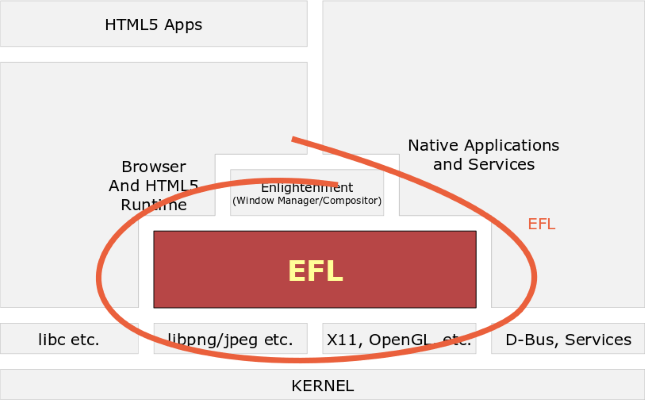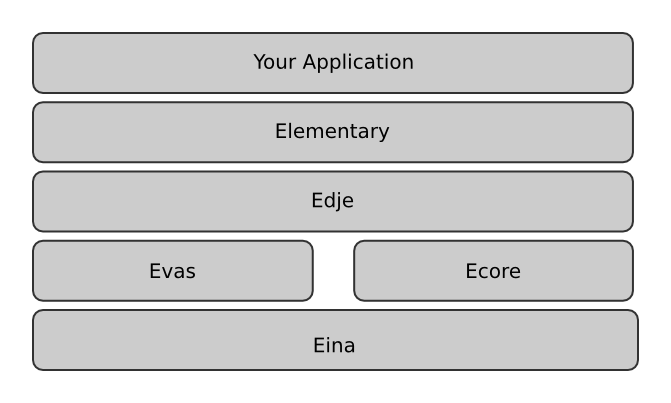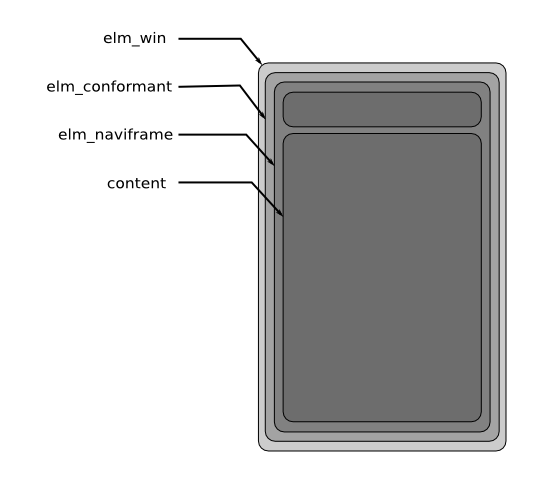EFL
Tizen provides the functionality to create and manage your application user interface. The heart of the Tizen application UI is the native UI framework, which consists of the Enlightenment Foundation Libraries (EFL).
UI design with EFL consists of the following main parts:
- EFL
EFL basics contain a set of layered libraries, and EFL functions as the window manager for your application:
- EFL Extension
The EFL Extension is an extension package for EFL. It provides functions to work with the Menu and Back hardware keys on devices.
- EFL Extension
- Edje
The Edje library is part of EFL, and provides APIs for theming a Tizen application, by writing EDC file. EDC programming supports part positioning, resizing, and animations.
- Elementary
The Elementary library is part of EFL, and provides the basic toolkit for window and layout management, along with the UI and container components for the user interface (in mobile and wearable applications). You can manage the UI components and their focus on the screen, as well as create customizations.
Some general UI design features include:
- Animations and effects
Tizen supports various methods to create animations and effects in your application.
- Event handling and main loop
The user interface relies on callbacks designed to react to EFL events generated by the system or the user. You can handle various events, from low-level Ecore system events to Evas smart object events that happen on object collections.
The Ecore library provides a main loop abstraction that gets you data when it is available and sends you events. You can manage the main loop and use threads with the Ecore main loop.
- Font settings
Tizen supports various methods to change the font of your application to another system default font or your own font.
- Scalability
Elementary provides a way to scale UI components (in mobile and wearable applications) in order to be comfortably used with a finger and to make the text more readable.
Figure: EFL

Making EFL Applications
The Enlightenment Foundation Libraries (EFL) provide all the libraries you need to create powerful applications. This section presents an overview of the libraries and when to use them in developing applications.
Enlightenment is a window manager, which in the X Window System means that it handles the borders, iconification, expansion, and movement of windows on the screen. Enlightenment can also provide multiple virtual desktops. The initial version was developed in the 1990s by Rasterman (Carsten Haitzler). Enlightenment has since become much more than a simple window manager. To create this window manager, the Enlightenment team needed powerful libraries to base their work on, which is where the EFL come in. The EFL are the libraries on which the window manager was initially based on, but which have since then become more powerful, more memory efficient, and especially more useful for the embedded world and for touchscreen interfaces.
The EFL are a set of layered libraries, as shown in the following diagram:
Figure: EFL layers

When you create a basic EFL application, you use the following main libraries as a basis:
- Elementary is the top-most library with which you create your EFL application. It provides all the functions you need to create a window, create simple and complex layouts, manage the life cycle of a view, and add UI components. The full list of UI components that can be used in Tizen can be found in Using UI Components (in mobile and wearable applications).
- Edje is the library used by Elementary to provide a powerful theme. You can also use Edje to create your own objects and use them in your application. You may also want to extend the default theme. You will find more information about Edje and the EDC format in Edje and Customizing UI Components.
- Ecore is the library which manages the main loop of your application. The main loop is one of the most important concepts you need to know about to develop an application. The main loop is where events are handled, and where you interact with the user through the callback mechanism. The main loop mechanisms are explained in the Main Loop guide.
- Evas is the canvas engine. Evas is responsible for managing the drawing of your content. All graphical objects that you create are Evas objects. Evas handles the entire state of the window by filling the canvas with objects and manipulating their states. In contrast to other canvas libraries, such as Cairo, OpenGL, and XRender, Evas is not a drawing library but a scene graph library that retains the state of all objects. The Evas concept is explained in Rendering Concept and Method in Evas. Evas objects are created and then manipulated until they are no longer needed, at which point they are deleted. This allows the developer to work in the same terms that a designer thinks in: it is a direct mapping, as opposed to having to convert the concepts into drawing commands in the right order, calculate minimum drawing calls needed to get the job done, and so on.
- Eina is the basis of all the EFL libraries. Eina is a toolbox that implements an API for data types in an efficient way. It contains all the functions needed to create lists and hashes, manage shared strings, open shared libraries, and manage errors and memory pools. Eina concepts are explained in Eina.
The EFL include more than just the above libraries, but the above are the most important libraries to get started with. The other libraries, such as Eet, Embryo, and Emotion, will be explored later in the programming guides and the API Reference.
When designing EFL applications, you can use the EFL Extension package to work with device hardware keys and the EFL UTIL package to provide additional notifications.
Concept of Elementary
Before writing an application, you should already have an answer to the following question: What is an application? An application is a process launched by the user. Every application has at least one window for presenting its content. Users can interact with the content through events. Different sources of events can modify the life cycle of the application. The application may receive data from a network connection, and it may also receive touch and key events. From the computer's point of view, an application is a collection of code that reacts to events and displays content on the screen. Elementary bridges this divide between the user and the code.
Elementary provides a variety of pre-built UI components, such as layout objects and components, that allow you to build rich graphical user interfaces for your applications. Every Elementary application has at least one window for presenting its content. The window provides the area in which to display the content and where the Evas canvas is placed.
There are three main groups of objects provided by Elementary:
- UI components: These are the components with which you build your application UI.
- Containers: These are the containers that hold the components.
- Infrastructure: These are the modules that deal with Elementary as a whole.
The Hello World example shows you how to develop your first application with Elementary and the EFL.
Basic Structure of an EFL Application in Tizen
Most of the time, your application has to manage multiple views. The easiest way to handle them with the EFL is to create a naviframe object. This object is a container. At first, it is used to contain the pages your application is composed of. Every Tizen application can use this top-layer object to facilitate navigation. More details can be found in the Naviframe Tutorial.
Another interesting object that has to be present in every application is the conformant object. Conformant is a container component that accounts for the space taken up by the indicator, virtual keyboard, and softkey windows. The conformant content will be resized and positioned based on the space available. When the virtual keyboard is displayed, the content does not change.
Figure: Basic EFL application structure

Basic Use of Appcore
In Tizen, the life cycle of an application is handled by appcore. Appcore is a dedicated library developed for Tizen that provides a set of functions for handling the application life cycle. For example, appcore is responsible for sending the correct signals when the application is created, when the battery is low, when the application is sent to the background, and when the screen is rotated.
You can see appcore in action in Handling the Application Fundamentals.


